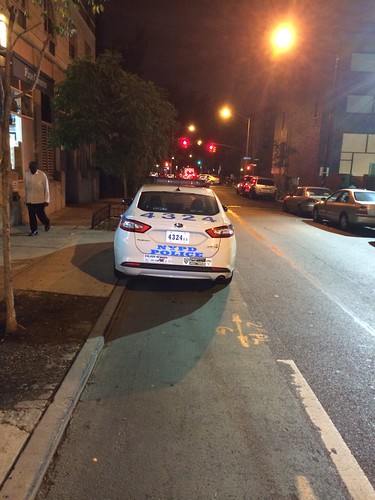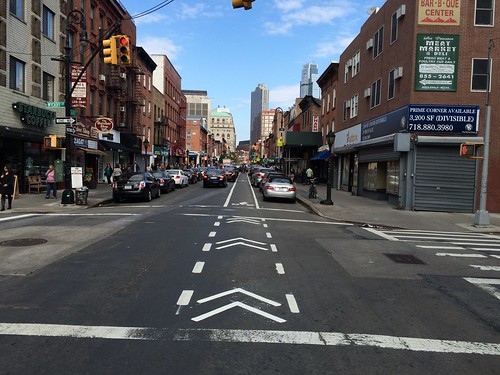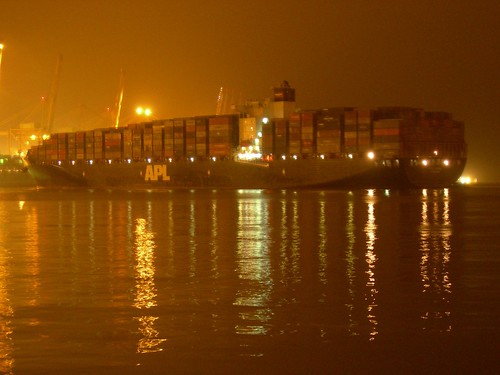It was as I was riding down 13th St in Park Slope, not far
from my apartment, last Sunday that I heard the sound of honking behind me. Looking
over my shoulder, I saw a black Lincoln Town Car – vehicle of choice for many New York City car
services – barrelling down the street towards me and my son, who was on his
trailer bike behind me.
 |
| New York City's official advice on where to ride in the road: not bedtime reading, I'd suggest for the guy I encountered |
But my response wasn’t what the driver obviously hoped it
would be. Knowing that the street’s single lane, though wide, lacked the space
for a wide vehicle to pass safely at speed, I steered into the very centre of
the lane, preventing his attempted pass. At the next traffic light, he pulled
up next to us and yelled how I should have been over to one side of the street.
He then gave a loud blast on his horn and passed aggressively and fast. At the light
after that, I asked his passenger please to withhold her tip.
The driver was inconsiderate and dangerous, as I pointed out
in my subsequent complaint to the Taxi & Limousine Commission (top tip,
for-hire drivers: behave especially well if you’ve got an easily-remembered
licence plate). But he also misunderstood the complicated relationship between
space and speed. There are circumstances where it might be safe for a 6’ 6”
wide car to pass a bicycle on a 28’ wide street where parked cars are taking up
8’ on either side. But they don’t include occasions when a person is riding a
bicycle laden with groceries and hauling a trailerbike at 17mph downhill.
 |
| In the debate about how best to allocate space on the roads, New York's police department prefers to make practical demonstrations of its position. |
It’s at the root of very many of my arguments with motorists
that few seem to understand how I expand the buffer zone I’m mentally defending
around myself as my own and other road users’ speed increases. I’m sure that many
motorists see me and other cyclists squeezing past stationary cars and jump to
the wrong conclusions. It’s a very different business riding close to a
stationary motor vehicle and next to one doing 40mph while one’s riding at
20mph. Fast-moving vehicles travel far farther while the driver is processing
the need to stop and then need a far greater distance to come to a halt. It
should be obvious that every mile per hour of extra speed disproportionately
expands the invisible balloon of space I need to keep free.
The point is especially important because so many of the
disputes about how to accommodate growing levels of cycling use – or cities’
aspiration to have more journeys by bike – come down to the allocation of road space. The debate is an asymmetric one at present. Nearly anyone who regularly
rides a bike in a city will have thought about the space he or she can use on
the roads, how the space is apportioned and the issues that that allocation
raises. Many people who drive cars around cities seem instinctively to think
the roads should be freer of obstructions in front of their cars, wider and
more conducive to high speeds. To such a view, any space taken away from cars
is being stolen from its rightful owners.
The whole issue has reminded me of a
reporting visit I undertook 10 years ago to Line 14 of the Paris metro, the city’s first entirely
driverless metro line. I noticed how trains slowed down from their 80kph
(50mph) top speed well in advance of the terminal station if another train was
occupying the platform. But then, as the trains slowly negotiated the junctions
at the end of the line before turning back, they would come almost in touching
distance of each other. They were under the control of one of the world’s most
advanced signalling systems. It was constantly calculating the balloon of space
it needed to maintain between trains, providing many train lengths’ of empty
space in front of each train at top speed but barely any at 10kph (6mph).
 |
| Smith St, Brooklyn: it's a bike lane but also, on a busy morning, a corridor of collision uncertainty. |
A chaotic, busy street makes far more sense if one pictures
every object encased in balloons of space like those that Line 14’s signalling
system projects in front of trains. Every vehicle operator should be maintaining
in front of him or her enough empty space to stop safely in the event that an
unexpected danger crops up. But, just as importantly, everyone on the street
needs to plot the trajectories of other vehicles or other potential obstructions.
Looked at this way, it’s clear why suddenly-opened car doors pose such a danger.
No other obstruction can appear as suddenly or with as little warning as a
suddenly-opened car door. I refused to let the angry car service driver past to
avoid being forced into the door-opening danger zone. To the driver, I’m sure
that looked like a willful refusal to go into an unused, empty zone.
It’s because I draw a safety balloon round any moving
vehicle that I find myself at least once a week in shouted conversation with
the drivers of vehicles that have started pulling into my path. “Stop!” I’ll
shout as the vehicle keeps moving across my path. “I see you!” the motorist
shouts, exasperatedly, as if I should implicitly trust that the driver of a
slow-moving vehicle on a collision course with me will not immediately turn
into a faster-moving one.
 |
| The APL Pearl turns at the Port of Salalah: I yearn for her navigational equipment, if not her limited maneouvrability. |
I yearn for something like the collision-avoidance radar I
watched a pilot use seven years ago as the APL Pearl, a container ship on which I was travelling, negotiated the chaotic shipping lanes of the English Channel . Each vessel’s radar plot had in front of
it a line showing where it would be within six minutes. Slow-moving oil tankers
and bulk carriers sported only relatively small, short lines. The lines before
container ships like our own were longer. However, a fast ferry emerging from
the Port of Boulogne
The more one ponders the complexity of the interactions on a
shared-use street – or the English Channel -
the less one becomes surprised at people’s tendency to crash into each other.
The surprise is how effectively most of the time people manage to miss each
other.
Yet a trip the week before my run-in with the Impatient Car
Service Driver of 13th
Street suggested a different lesson about space. I
was visiting the Burlington Northern Santa
Fe railroad in North Dakota ,
where sudden, unexpected growth in both agricultural and oil traffic has led to significant congestion. As we drove by the company’s main line across the
region, we saw an Amtrak passenger train zipping along the main line at 70mph, far
faster than the 50 or 60mph common for freight trains on the route. “I’ll bet
that really eats up capacity,” I said to the railroad people, to a resigned
harrumph of acknowledgement.
 |
| A BNSF oil train near Ross, North Dakota: the drivers are probably not grateful they share their tracks with faster, lighter passenger trains. |
No railwayman relishes running trains of sharply-varying speed
next to each other. The fast ones constantly catch up with the slower trains in
front, leaving unused space behind them. The slow ones constantly fall behind,
leaving unused space in front of them.
It's key to improving road safety to control vehicles' speeds on city streets and New York in particular needs to do a far better job of the task. But there is also, it occurs to me, an Amtrak-type effect on many
congested streets where bikes, cars, buses and others share space. The
differing braking and acceleration statistics of the different vehicles waste
space and capacity as effectively as if the New York subway decided to run the
F Train with a mixture of the latest electric subway trains and its plodding
diesel maintenance trains. Were New York ’s
Department of Transportation to provide properly-segregated bicycle lanes on
downtown Brooklyn ’s most chaotic streets, it’s
easy to imagine that they would instantly become far more efficient places, as
well as far safer ones. It’s perhaps time to label such streets as optimised
streets, rather than simply safe ones.
It will, of course, be some time before all the hundreds of
backstreets like the one where I was riding last Sunday will justify such
optimisation. While the ultimate cure for episodes like the one I encountered might
be surgery for the street, the short-term response will still be for the driver
to take a don’t-be-an-inconsiderate-fool pill.
But the spaces under the streets of many cities and the rail
lines that march across many countries’ open spaces show that transport can be
conducted in an orderly, safe, efficient manner. It would be a tragedy not to
learn at least a little more from them.
Update: I've just heard (on February 25, 2015) that the limo driver who harassed us has been dealt with - with a $200 fine an no points on his licence. I'm glad he's faced some penalty. But this strikes me as fairly paltry - and heightens my concerns about Taxi and Limousine Commission procedures.
Update: I've just heard (on February 25, 2015) that the limo driver who harassed us has been dealt with - with a $200 fine an no points on his licence. I'm glad he's faced some penalty. But this strikes me as fairly paltry - and heightens my concerns about Taxi and Limousine Commission procedures.
this air traffic controller can attest that the same problem/solutions occur when aircraft of different velocities need to line up for the same bit of pavement (runways) - the solution is to provide exorbitant amounts of operationally expensive space, enforce a common operating speed (170 knots), or a hybrid of practical speed constraints in conjunction with spacing for compression.
ReplyDeleteVannevar,
DeleteI didn't manage to get aviation in there, so thank you for bringing your professional knowledge to this particular party. I suppose one difference between aviation and the other modes of transport I've mentioned is that aircraft leave wake turbulence, meaning it's important to leave space behind. For trains and ships, the biggest problem is stopping and manoeuvring.
All the best,
Invisible.
Quite so, well said. Aviation has recognized that operating big heavy vehicles introduces additional implications; there'd be so many benefits to recognizing the same pattern with respect to HGV's.
DeleteI don't know how close driverless car technology is to being widely introduced. But I think it can hardly make road conditions worse if vehicles are being manoeuvred under a clearly-defined set of operating rules which prioritise safety.
DeleteHeck with driverless cars, let's get "driverless doors" that cannot be opened by the nut behind the wheel when something is coming up from behind that would be hit. Certainly that would not save cyclists from older car doors, but it would be simple, cheap, and we wouldn't have to watch that idiot get her door torn off any more in the Liberty Mutual commercial.
ReplyDeleteSteve,
DeleteIt's a good idea - no doubt about it. There are actually quite a lot of small safety fixes like that now. Last year, I drove a new Buick LaCrosse that flashed a sign in the wing mirrors to warn me when vehicles were passing me. So it's coming.
I think engineers should prioritise nearly all the kinds of accidents that feature heavily in car insurance commercials. It would at least make the ad agency creatives earn their money thinking up new scenarios.
All the best,
Invisible.